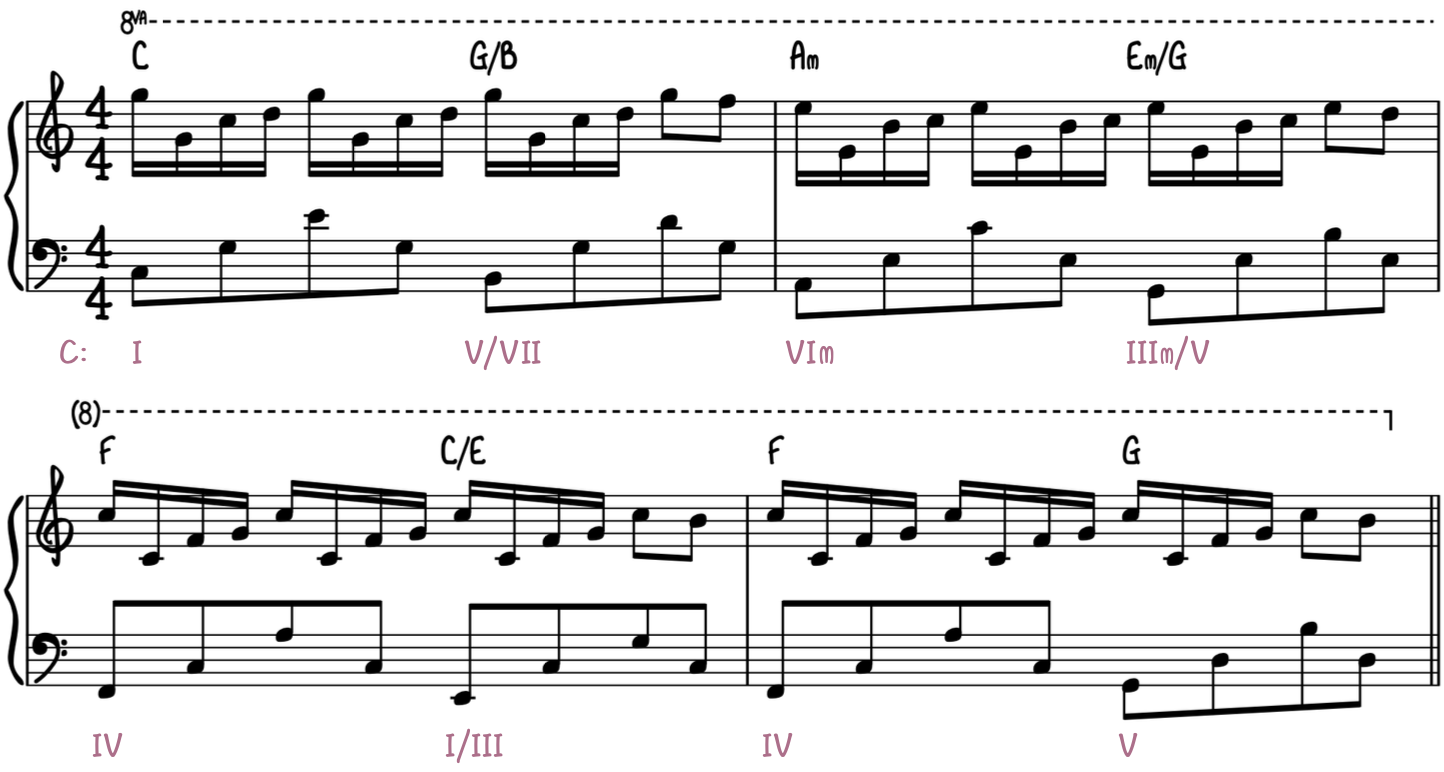4 Steps to Play Romantic Piano
Learning Focus
Music Style
Free Lessons
Get free weekly lessons, practice tips, and downloadable resources to your inbox!
Have you ever wanted to be able to sit down at the piano and serenade your soulmate with beautiful improvised melodies? Well, in today’s Quick Tip, 4 Steps to Play Romantic Piano, Jonny May helps you train your fingers do the talking the next time that true love has you at a loss for words. You’ll learn:
Intro to Romantic Piano
There are very few things in life more romantic than the sound of a slow, tender piano ballad. In fact, when you add in a touch of improvisation, then the effect is even more sublime. If this is one of your goals as a piano student, then you have truly exquisite aspirations. Moreover, you’ve also come to the right place, because that’s exactly what you’ll learn in this lesson! Just follow the 4 simple steps in today’s lesson outline.
If you’re already a PWJ member, then be sure to grab the downloadable PDF and backing tracks for this lesson, which are included with your membership. These resources will appear at the bottom of this page after you’ve logged in with your membership. In addition, PWJ members can also easily transpose these romantic piano examples to any key using our Smart Sheet Music.
Learn to Play Romantic Piano With These 4 Steps
The following 4-step outline will enable late-beginner to intermediate level piano students to achieve their goal of playing romantic piano music. In addition, more advanced pianists will find deep reward in exploring the wealth of expressive possibilities that are available within these musical examples. In particular, these examples offer advanced players a unique opportunity to focus on carefully controlling dynamics and rubato, which is playing with an elastic sense of time.
Let’s begin with Step 1.
#1: The Love Progression
There is one particular chord progression that tends to surface over and over again in love songs. In fact, did you know that all of the following songs make use of the same basic chord progression?
- “Canon In D” (1680–90), Johann Pachelbel’s
- “Piano Man” (1973), Billy Joel
- “Jesus Is Love” (1980), The Commodores
- “Love in the First Degree” (1987), Bananarama
- “Love Will Be Our Home” (1988), Sandi Patty
- “Cryin'” (1993), Aerosmith
- “Basket Case” (1994), Green Day
- “Can You Feel The Love Tonight” (1994), Elton John
- “Graduation (Friends Forever)” (1999), Vitamin C
- “Memories” (2019), Maroon 5
Here at PWJ, we simply call this familiar succession of chords “The Love Progression.” Often times, songwriters present this chord progression with a few different tweaks, such as employing different passing chords. Still, the overall harmonic thrust is essentially the same. The example below shows The Love Progression in C major in its most basic form.

In the example above, all of the chords are in root position—just as we’re accustomed to hearing this progression in Pachelbel’s “Canon in D.” In the next step, you’ll discover another common manner in which The Love Progression is frequently used in romantic piano songs.
#2: Descending Bass Line
Now, let’s examine one of the most common formats that songwriters use when arranging romantic songs based on The Love Progression. In this step, we’ll apply chord inversions to the chords that fall on beat 3 in bars 1–3. These 1st inversion chords produces a smooth, stepwise bass line that results in a tender and delicate romantic piano effect.

In sheet music notation, chord inversions are expressed with slash chord symbols containing two parts separated by a slash. The letter in front of the slash represents the primary chord and the letter after the slash indicates the bass note. Therefore, in slash notation, the chord symbol G/B indicates a G major triad with the note B as the bass note. [learn more about slash chords]
In the next step, you’ll learn how to propel this progression along by adding 8th notes in the left hand.
#3: Left-Hand Broken Chords
One of the hallmark techniques of romantic piano music is its flowing character. Therefore, let’s learn how to achieve this musical effect by adding an 8th-note pattern in our left hand. The following example shows one possible accompaniment pattern using broken chords (aka arpeggios).

The accompaniment pattern in the example above is based on beautiful, open-position triads. However, if you’re more of a beginner, you can play a similar pattern with closed-position triads instead.
For a deep dive on The Love Progression, including additional left-hand patterns and right-hand improv tips, check out the following full-length course:
#4: Romantic Piano Improvisation
The fourth step to playing beautiful romantic piano music is to add an improvisational dimension to your playing. Therefore, let’s consider five versatile techniques that you can use to add some personal expression to The Love Progression. These tips will enable you to add a pro touch when accompanying over this progression. Plus, you can also combine these techniques together with improv scales to play an improvised solo.
Here are the five techniques we’ll consider:
Now, let’s take a closer look at each improv technique.
a. The Sus Walkdown
The Sus Walkdown technique uses a melodic ornamentation technique called a suspension, which Billy Joel once poetically described as a “hanging note” [see reference]. The suspension in a non-chord tone that resolves or settles into the chord just a little bit after the chord arrives. Let’s take a listen.

Notice that when we play The Love Progression with the Sus Walkdown technique, we use root position chords throughout the progression. That’s because suspensions are dissonances that we deliberately create over the root of the chord as the bass note. In fact, there are two different types of suspensions employed in this example: 9-8 suspensions and 4-3 suspensions. The numbers in these terms refer to intervals above the root of the chord. Hence, the first number is the intervallic distance of the suspended note above the root. Naturally, the second number is the intervallic distance of the resolution note above the root of the chord. In fact, each suspension type in the example above is labeled for your consideration.
b. Middle Slips
Another great sounding improvisatory technique that you can add to The Love Progression is slip notes—designated here as “middle slips” because we’re employing this technique in the middle of the chord. Slip notes are notated in sheet music with smaller noteheads—just like grace notes. However, slip notes are actually a separate and unique articulation technique. Thus, they’re not played in quite the same manner as grace notes would be played in the Classical piano tradition. Instead, the slip note is played simultaneously with the upper harmony note. Then, immediately after the initial attack, the slip note gives way or “resolves” to the larger note that appears to its right. The following example demonstrates how to interpret slip notes in contemporary piano styles.

c. Interval Rocking
Next, let’s explore interval rocking, a delicate and simply-stated right-hand technique that can be used to gently adorn the broken-chord accompaniment in our left-hand. Interval rocking creates captivating sonorities by taking a four-note voicing and dividing it into overlapping, oscillating interval pairs. For instance, in the following example, the right-hand notes on beats 1 and 2 of the first measure are derived from interval rocking the 4-note C major voicing E–G–C–E.

d. Magical 3rds
Another beautiful, romantic piano improv technique is “magical 3rds.” You can create this elegant pro touch by harmonizing an improvised melody with 3rd intervals. Note, this technique is particularly effective when the melodic line primarily uses stepwise motion, as in the following example.

e. Ostinatos
Lastly, when you’re ready to play out with a bit more energy in the right hand, ostinatos are a great “go to” technique. An ostinato is simply a repeating musical figure or pattern. For example, the following melody employs a 16th-note ostinato figure in each measure based on a simple hand shape. Specifically, the hand shape in measure 1 is G–C–D-G (from bottom to top). Similarly, the ostinato in measure 2 is based on the hand shape E–B–C–E. Finally, measures 3 and 4 are based on the hand shape C–F–G–C.

Conclusion
Congratulations, you’ve completed today’s lesson on 4 Steps to Play Romantic Piano. Once you have these romantic piano techniques under your fingers, you’ll find that expressing your true feelings on the piano will feel more natural than ever!
If you enjoyed this lesson, then you’ll love the following PWJ resources:
Courses
- The Love Progression Challenge (Beg–Adv)
- The Love Progression (Int)
- Contemporary Progressions and Improv (Beg/Int, Int/Adv)
- Pachelbel Canon in D (Int, Adv)
- The Sentimental Progression (Int, Adv)
- Pop Piano Accompaniment: The One Chord Wonder (Int)
- Pop & Contemporary Accompaniment Patterns (Beg/Int, Int/Adv)
Quick Tips
- Play Canon in D in 5 Easy Steps (Beg–Int)
- 15 Wedding Songs You Should Know for Piano (Int)
- Play Background Music On Piano (Beg–Adv)
- 5 Sad Piano Chord Progressions (Int)
- Beginner Guide to Improvise Piano (Beg)
- How to Improvise Contemporary Piano (Beg–Int)
- Easy Piano Improv–4 Steps for Beginners (Int)
- Piano Chord Shapes for Beautiful Improv (Int)
Contemporary & New Age Piano Learning Tracks
Piano Foundations Learning Tracks
Thanks for learning with us today! We’ll see you next time.
Would you like to comment on this lesson?
Visit this Quick Tip on YouTube
 Writer
Writer
Michael LaDisa
Michael LaDisa graduated from the University of North Texas with a major in Music Theory & Composition. He lives in Chicago where he operates a private teaching studio and performs regularly as a solo pianist. His educational work with students has been featured on WGN-TV Evening News, Fox 32 Good Day,...
More Free Lessons
Want to master piano chords? In this one-year practice plan, I show you what to practice every day for the next year.
Struggling to play blues piano with skill and sensitivity? Master these blues piano left hand patterns to take your feel to the next level!
Explore the methods and mindset needed to comp on piano in the swing style with this complete guide to jazz piano comping for all levels.
Looking for downloads?
Subscribe to a membership plan for full access to this Quick Tip's sheet music and backing tracks!
Join Us
Get instant access to this Quick Tip and other member features with a PWJ membership!
Guided Learning Tracks
View guided learning tracks for all music styles and skill levels
Progress Tracking
Complete lessons and courses as you track your learning progress
Downloadable Resources
Download Sheet Music and Backing Tracks
Community Forums
Engage with other PWJ members in our member-only community forums
Become a better piano player today. Try us out completely free for 14 days!



